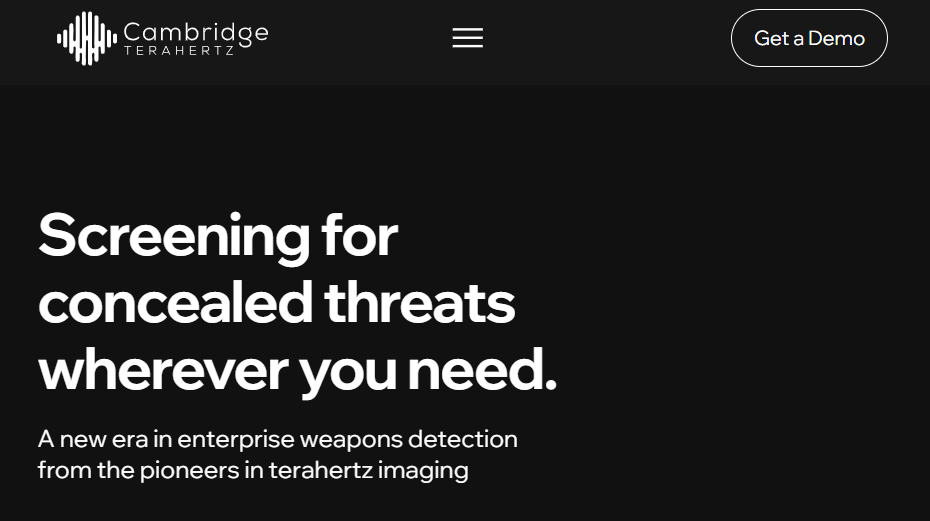Cambridge Terahertz Raises $12M Seed Round to Reinvent Threat Detection With Passive Imaging Tech
July 30, 2025
byFenoms Startup Research

Cambridge Terahertz, a Boston-based deep tech startup developing next-gen screening technology for concealed threats, has raised $12 million in seed funding to scale its terahertz imaging platform. The round includes heavyweight participation from Felicis, Amazon, Tishman Speyer, Plug and Play Tech Center, Good Growth Capital, and Stata Capital, among others.
With this raise, the company plans to accelerate product development, regulatory approvals, and deployment of its discreet, non-invasive imaging systems in public safety, infrastructure, and high-security commercial settings.
Why It’s a Breakthrough
Traditional screening technologies - X-rays, metal detectors, and millimeter-wave scanners - are effective but intrusive. They generate lines, discomfort, and growing privacy concerns. Cambridge Terahertz is changing that by offering a walk-through experience that requires no friction and exposes no data.
With heightened security risks, cities and facilities need to evolve their approach from episodic screening to ambient safety layers - something Cambridge delivers with precision.
According to Research and Markets:
- The global security screening market is projected to grow from $8.2 billion in 2023 to $12.7 billion by 2030, at a CAGR of 6.5%
- The passive terahertz imaging market is expected to see strong adoption across transportation, defense, and smart city applications
- Over 4.5 billion people passed through airport security in 2023, a number expected to double by 2040 (IATA), making scalable, efficient screening systems a global priority
What Is Cambridge Terahertz?
Cambridge Terahertz is pioneering passive terahertz imaging technology that enables non-contact detection of concealed objects - such as weapons, explosives, or contraband - without exposing people to harmful radiation or requiring invasive pat-downs.
Unlike conventional scanners, which rely on X-rays or millimeter waves and require still positioning or cooperation, Cambridge’s system passively captures naturally emitted terahertz radiation, forming images without emitting energy.
The result? A frictionless, walk-through experience that detects threats in real time while respecting privacy and comfort. The company is initially targeting:
- Transportation hubs (airports, metros, train stations)
- Event venues and stadiums
- Government buildings
- Corporate campuses and data centers
- Public safety and defense applications
Why It Matters Now
As global security threats evolve, current screening technologies are struggling to keep up - both in accuracy and user experience. Long lines, invasive procedures, and outdated tech remain common pain points in security screening. Meanwhile, institutions are under pressure to enhance threat detection without degrading civil liberties or operational flow.
That’s where Cambridge Terahertz comes in: combining physics, privacy, and precision in one autonomous layer of protection.
According to a report by MarketsandMarkets, the global security screening market is projected to reach $12.7 billion by 2030, driven by increased threats to public infrastructure and heightened demand for contactless, scalable solutions. Governments are also increasingly mandating next-gen technologies for transit and high-density gathering zones.
In regulated, high-stakes industries, go-to-market isn’t just about speed - it’s about system trust. Cambridge Terahertz isn’t just building cutting-edge hardware. They’re building infrastructure-compatible trust systems - quietly replacing legacy screening workflows with smarter, invisible alternatives.
What sets them apart isn’t just the terahertz science. It’s the strategic embedding of their product where friction exists but compliance is mandatory. Think airports, border crossings, stadium entrances - places where people have to pass through a checkpoint. By focusing on passive scanning that respects privacy and reduces throughput delays, Cambridge isn’t asking for behavior change. They’re making protection ambient.
Here’s the deeper insight:
If you're building in deep tech, your tech doesn't need to be loud - it needs to be inevitable. Passive tech that aligns with human behavior scales faster and faces less resistance. Cambridge is a prime example of engineering that doesn't just innovate - it integrates.
Industry Context: A Growing Demand for Passive, Non-Invasive Screening
The need for more intelligent threat detection is rising fast. Here’s why:
- Global air traffic is expected to reach 9.4 billion passengers by 2040, according to IATA, which puts massive strain on existing screening infrastructure.
- In 2023 alone, the U.S. TSA processed over 2.9 million passengers daily, highlighting the need for faster, frictionless scanning technologies.
- Public venues - from music festivals to government buildings - are investing in non-invasive screening systems that don’t require people to stop, queue, or remove items.
Additionally, rising public awareness of data privacy and bodily autonomy is pressuring institutions to adopt tech that minimizes perceived surveillance or invasiveness. Passive terahertz imaging hits this sweet spot: high fidelity, low visibility, zero radiation.
Who’s Behind the Round
Cambridge Terahertz’s $12M seed round includes a formidable coalition of investors:
- Felicis, a top-tier VC known for early bets on transformative frontier technologies.
- Amazon, backing technologies aligned with its smart infrastructure and AWS defense portfolios.
- Tishman Speyer, a global real estate giant signaling use cases for commercial buildings and urban infrastructure.
- Plug and Play Tech Center, a major accelerator connecting security tech to enterprise and government partners.
- Good Growth Capital and Stata Capital, both focused on early-stage innovation in hard science.
Their involvement highlights confidence not only in the technology but in the leadership’s ability to navigate complex commercial, regulatory, and security environments.
What’s Next for Cambridge Terahertz
Armed with fresh capital, the company plans to:
- Refine and finalize product development for multi-environment compatibility (indoor/outdoor, variable lighting, crowd density).
- Pursue key certifications and government compliance to accelerate public sector adoption.
- Deploy pilots in major transit hubs and enterprise buildings across North America and Europe.
- Grow its technical and business development teams to support scale, customization, and integration with existing security infrastructures.
In a world where safety, speed, and dignity must coexist, Cambridge Terahertz is building the next frontier of silent, intelligent protection. Their technology blends physics, privacy, and precision - replacing anxiety with assurance, and checkpoints with peace of mind.









